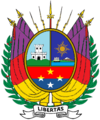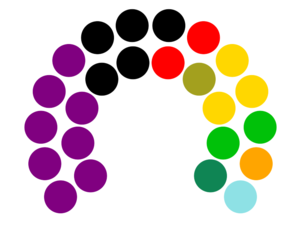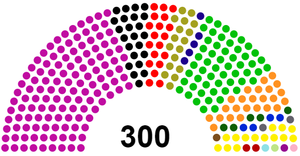Congress of the Confederated States of Gran Verionia: Difference between revisions
| Line 251: | Line 251: | ||
{| border="1" cellpadding="4" cellspacing="0" class="wikitable" style="border-collapse: collapse; text-align:center" | {| border="1" cellpadding="4" cellspacing="0" class="wikitable" style="border-collapse: collapse; text-align:center" | ||
|- | |- | ||
!width=" | !width="200"|Electoral district | ||
!width=" | !width="40"|Population | ||
!width="20"|Allocated seats | !width="20"|Allocated seats | ||
|- | |- | ||
Revision as of 20:01, 20 April 2020
| Congress of the Confederated States of Gran Verionia Congreso de los Estados Confederados de Gran Verionia | |
| 1st Congress | |
 | |
| Type | |
|---|---|
| Type | |
| Houses |
Consejo de los Estados Cámara de Representantes |
| History | |
| Founded | 1683 |
| Preceded by | Grand Council of Verionian States |
| Structure | |
| Seats |
Consejo de los Estados: 24 Cámara de Representantes: 421 |
 | |
Consejo de los Estados political groups |
Government (16) Partido Unionista : 8 seats Verionist Union: 5 seats Partido de Liberación Nacional: 2 seats Association of Merchants: 1 seat
Opposition (8) Cambio Democratico: 3 seats Al-Wafd: 2 seats Hizbusoufi: 1 seat Kasterburger Volksbond: 1 seat Progressieve Alliantie: 1 seat |
 | |
Cámara de Representantes political groups |
Verionian Unionist Coalition (189) Partido Unionista : 125 seats Verionist Union: 23 seats Partido de Liberación Nacional: 19 seats Association of Merchants: 17 seats Princely Delegation: 5 seats
Coalition for Tradition and Values (91) Al-Wafd: 55 seats Hizbusoufi: 24 seats Kasterburger Volksbond: 5 seats Partido Conservador: 4 seats Nationalist Coalition of Benacia: 2 seats Partido Fascista Republicano: 1 seat
Group for Democracy (17) Cambio Democratico: 14 seats Syndicalist Front: 2 seats Progressieve Alliantie: 1 seat
Coalition for the Regions (3) Sovereign Keraqi Front: 1 seat Acción Popular de Timaro: 1 seat Elsenari and Lunatic Union: 1 seat |
| Elections | |
Consejo de los Estados voting system |
Elected by regional legislatures |
Cámara de Representantes voting system |
First-past-the-post constituency voting |
| Meeting place | |
| Palacio de Mármol | |
The Congress of the Confederated States of Gran Verionia (Martino: Congreso de los Estados Confederados de Gran Verionia) is the bicameral parliament of Gran Verionia. It was established in 1683 to replace the Grand Council of Verionian States. The Congress consists of the 24-seat Council of States and the 421-seat chamber of representatives.
The bicameral parliament was introduced in 1683 to establish a better representation of the entire nation following the Northern Expansion. The Council of States was introduced, which functions as a non-proportional representation of the Republics, States and Territories of Gran Verionia.
Consejo de los Estados
The Council of States is the upper chamber of the Congress. The role of the Council is to ratify legislation passed by the Chamber of Representatives, as well as to confirm government appointments. Its members represent the Republics, States and Territories of Gran Verionia. The members of the Council of States are appointed by the local legislatures. The membership of the Council of States is not representative. Each Republic appoints three members of the Council, while each State and Territory appoints two.
| State | Council Member | Political Allignment | Term Started | |
|---|---|---|---|---|
| Kasterburg Republic | Jehosephat de Montfort | Kasterburger Volksbond | 1683 | |
| David van der Meer | Verionist Union | 1683 | ||
| Karel Santen | Progressieve Alliantie | 1683 | ||
| Republic of Los Liberados | Pedro Jimenèz Infante | Partido de Liberación Nacional | 1683 | |
| Ernesto Martinèz Campo | Partido de Liberación Nacional | 1683 | ||
| Martha Solaño Rosario | Cambio Democratico | 1683 | ||
| State of Aracataca | Ignacio Sanchèz Herado | Cambio Democratico | 1683 | |
| César Velarde Quito | Partido Unionista | 1683 | ||
| State of Cajamara | Simón Canas Vea | Partido Unionista | 1683 | |
| Régulo Esquilin Camarena | Partido Unionista | 1683 | ||
| State of Isabella | María Ramirez Tejera | Partido Unionista | 1683 | |
| Santiago Leyba Baez | Partido Unionista | 1683 | ||
| State of Granada | Nawid Herera | Partido Unionista | 1683 | |
| Patricio Al-Hasam | Cambio Democratico | 1683 | ||
| State of Souf | Ali Al-Shafed | Hizbusoufi | 1683 | |
| Chaim Viqh | Association of Merchants | 1683 | ||
| State of Torosh | Jamal Bin Osman | Al-Wafd | 1683 | |
| Ibrahim Al-Ramadi | Al-Wafd | 1683 | ||
| State of Valentia | Emerico Calleja Rejo | Partido Unionista | 1683 | |
| Ana Fleites Serna | Partido Unionista | 1683 | ||
| Free City of Chryste | Rodrick Delacroix | Verionist Union | 1683 | |
| Howard Valz | Verionist Union | 1683 | ||
| Capital Territory of Valarion | Sarah Bezir | Verionist Union | 1683 | |
| Oliver Hasenda | Verionist Union | 1683 | ||
Cámara de Representantes
The Cámara de Representantes replaced the existing Grand Council. Before 1683, members of the Grand Council were elected or appointed in their representative states. Seats were distributed according to population of the Verionian States. Since the Northern Expansion, a series of changes was made to the way in which the parliament was elected. Whereas the Consejo remained appointed by the States, the Cámara became a national legislature that is directly elected in one national election. The change was controversial, especially in Souf and Valentia, states which saw their influence decrease following the 1683 General election.
Powers
The Cámara de Representantes has the power of legislation, but this legislation, either through acts or resolutions, have no binding power. Acts may have binding power when they receive the support of a 2/3rd majority of the Cámara, are agreed on by the Consejo de los Estados by a simple majority and are promulgated by the Supreme Director. Resolutions never have binding power, but are recommendations that may or may not be taken over by the Consejo.
Distribution of Seats
For the general election that elects the Cámara de Representates, every Republic, State or Territory serves as an electoral district. Each electoral district has a predetermined number of seats that represent the population.
| Electoral district | Population | Allocated seats |
|---|---|---|
| State of Valentia | 25,600,000 | 116 |
| State of Isabella | 21,700,000 | 99 |
| State of Torosh | 11.000.000 | 50 |
| State of Cajamarca | 8,511,400 | 39 |
| State of Souf | 8,300,000 | 37 |
| Republic of Los Liberados | 7,170,000 | 33 |
| Free City of Chryste | 4,587,000 | 21 |
| Republic of Kasterburg | 2.220.300 | 10 |
| State of Aracataca | 2,100,000 | 9 |
| Capital Territory of Valarion | 1,100,000 | 5 |
| State of Granada | 520,000 | 2 |
Groups in the Grand Council of Verionian States
| Group | Seats | Ideology | Member groups | |
|---|---|---|---|---|
| Verionian Unionist Coalition | 189 | Verionian Unionism |
| |
| Coalition for Tradition and Values | 91 | Conservatism, Religious interest |
| |
| Group for Democracy | 17 | Democracy, Liberalism |
| |
| Coalition for the Regions | 3 | Regionalism |
|
Washar
The Grand Council elected a chairman, or Washar, from its ranks. The Washar is tasked with leading the debates and maintaining the order in the debating chamber. In addition, the Washar is the first advisor to the Elu, often mitigating between the wishes of the Grand Council and the monarchy. The last Washar was Godolphin Viqh, who is a member of the Association of Merchants, representing Souf.